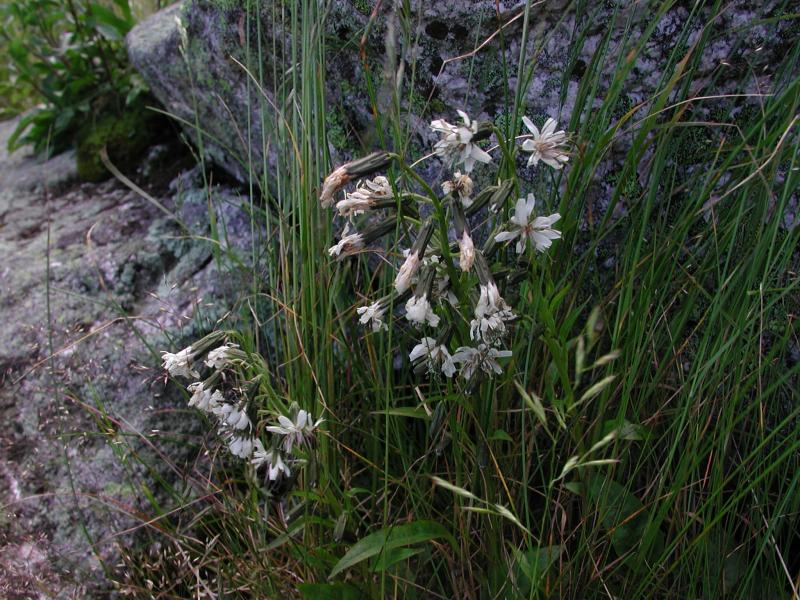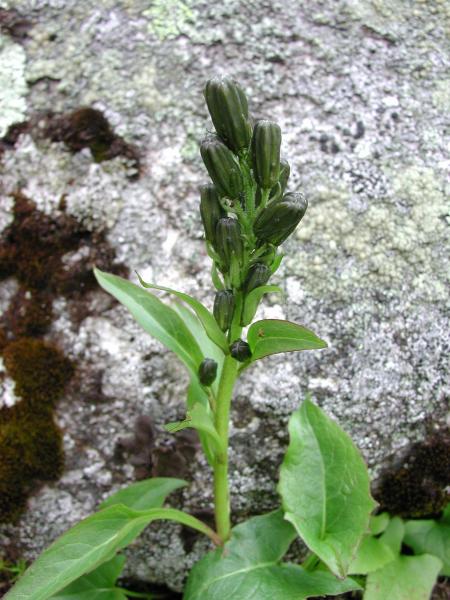Boott's Rattlesnake Root
Nabalus boottii D.C.
- Class
- Dicotyledoneae (Dicots)
- Family
- Asteraceae (Aster Family)
- State Protection
- Endangered
Listed as Endangered by New York State: in imminent danger of extirpation in New York. For animals, taking, importation, transportation, or possession is prohibited, except under license or permit. For plants, removal or damage without the consent of the landowner is prohibited.
- Federal Protection
- Not Listed
- State Conservation Status Rank
- S1
Critically Imperiled in New York - Especially vulnerable to disappearing from New York due to extreme rarity or other factors; typically 5 or fewer populations or locations in New York, very few individuals, very restricted range, very few remaining acres (or miles of stream), and/or very steep declines.
- Global Conservation Status Rank
- G2
Imperiled globally - At high risk of extinction due to rarity or other factors; typically 20 or fewer populations or locations in the world, very few individuals, very restricted range, few remaining acres (or miles of stream), and/or steep declines.
Summary
Did you know?
Boott's Rattlesnake-root is restricted to the northeastern United States where it only grows on a few mountain summits in New York and New England. The genus name comes from the Greek "prenes", drooping, and "anthe", flower, and it describes the habit of the flower (Fernald 1970). It is named after John Wright Boott (1788-1845) who first collected the plant in 1829 in the White Mountains of New Hampshire (Fernald 1970, Wallner and DiGregorio 1997).
State Ranking Justification
There are seven known populations in New York with only one that has over 500 individuals and four that have under 50. This species is globally limited in number of individuals and in extent of range being endemic only to the mountains of New England and New York.
Short-term Trends
In the past 20 years or so populations appear to have remained stable or to have fluctuated up and down slightly. These data may be somewhat inaccurate due to the difficulty of noticing and assessing all basal rosettes as well as the different levels of survey effort.
Long-term Trends
No populations are known to have become extirpated but there are no other clear data indicating what the long-term trends are for this species.
Conservation and Management
Threats
Although this species appears to do well and even thrive in disturbed areas it is unclear how human disturbances will impact this species in the long term. In some areas it is clear that trampling by hiker traffic has damaged populations. Many of the populations are in areas where trampling by hikers as well as other human created disturbances exist and unless it is clearly proven that these types of impacts are not damaging populations they should be considered threats.
Conservation Strategies and Management Practices
The Summit Steward program which works to inform hikers of the fragile nature of alpine plants is a critical program which is helping to reduce trampling of alpine vegetation. This program and other efforts designed to reduce trampling of alpine meadows are needed.
Research Needs
This species appears to do well in disturbed sites (including human created ones). At the same time, there is no clear information that these human created disturbances are benefiting populations in the long term. Therefore, investigation into the impact of human created disturbances including trampling by hikers is needed.
This species should be looked for in all alpine summit areas.
Habitat
Habitat
In New York, this species is restricted to a few of the highest peaks in the Adirondacks and grows in the alpine zone. In this area, plants occur in open grassy meadows, near rock outcrops, in seeps at the bases of cliffs, adjacent to krummholz, on ledges and crevices in cliffs, and along trails. It is also known from around buildings, a rock wall of a parking lot, and disturbed areas in the alpine zone (New York Natural Heritage Program 2007). Alpine areas above treeline, mountains (Bogler 2006). Alpine regions (Fernald 1970).
Associated Ecological Communities
- Cliff community
(guide)
A community that occurs on vertical exposures of resistant, non-calcareous bedrock (such as quartzite, sandstone, or schist) or consolidated material; these cliffs often include ledges and small areas of talus.
- Open alpine community
(guide)
An open community consisting of a mosaic of sedge/dwarf shrub meadows, dwarf heath shrublands, small boggy depressions, and exposed bedrock covered with lichens and mosses. The open alpine community occurs above timberline (about 4,900 ft or 1,620 m) on the higher mountain summits and exposed ledges of the Adirondacks. The flora includes arctic-alpine species that are restricted (in New York) to these areas, as well as boreal species that occur in forests and bogs at lower elevations. The soils are thin and organic, primarily composed of peat derived from peat mosses (Sphagnum spp.) or black muck. The soils are often saturated because they can be recharged by atmospheric moisture.
Associated Species
- Agrostis mertensii (northern bent)
- Carex bigelowii
- Carex scirpoidea ssp. scirpoidea (Canadian single-spike sedge)
- Diapensia lapponica (pincushion-plant, diapensia)
- Empetrum nigrum ssp. hermaphroditum
- Hierochloe alpina ssp. orthantha
- Huperzia appressa (mountain firmoss)
- Prenanthes nana
- Salix uva-ursi (bearberry willow)
- Sibbaldiopsis tridentata
- Solidago leiocarpa (Cutler's alpine goldenrod)
- Trichophorum caespitosum
- Vaccinium uliginosum (bog bilberry)
Range
New York State Distribution
In New York this species is restricted to only a few of the highest peaks of the Adirondacks.
Global Distribution
This species is endemic to only a few high peaks in Maine, New Hampshire, Vermont, and New York (Bogler 2006).
Identification Comments
General Description
Boott's rattlesnake-root is a low growing herb. It forms whorls of leaves at ground level from a short taproot. It may take an individual plant some number of years to produce a flowering stalk and flowers. After that time the plant dies. New offshoots are sometimes produced from the roots and these become separated from the original plant to form new clones. Leaves are simple and not lobed or divided. The leaf base is arrow-shaped. The flowering stalks, which are up to 10 inches tall are either straight or have bases which trail along the ground. The bright white flowers are small, with the styles conspicuously longer than the petals, and occur in groups (heads) surrounded by dark green to black phyllaries. There are 10-20 mostly nodding heads per plant. The fruits have fine hairs at the summit similar to dandelions (Popp 1995, Bogler 2006).
Identifying Characteristics
Prenanthes boottii has flowering stems distally pubescent. The proximal leaves have blades deltate to ovate with the bases sagitate to hastate and the margins at most weakly dentate. Involucral bracts (including the outer series) are glabrous and black to dark green. There are 9-20 white florets per head and 10-20 heads per plant. The pappus is pale yellow (Bogler 2006).
Best Life Stage for Proper Identification
Plants need to be in flower or immature fruit to be identified properly. The whole plant is generally needed for identification but due to its extreme scarcity it should not be collected. Photos of the whole plant including basal and proximal leaves, close up of stems, and close up of flowers should be adequate to confirm identification.
Similar Species
As with most other Prenanthes species, P. boottii is difficult if not impossible to identify vegetatively.
Prenanthes altissima, which can occasionally grow in high elevation sites, has only 4-6 florets per head as opposed to 9-20 for P. boottii.
Prenanthes trifoliata and P. nana, which are sometimes lumped under P. trifoliata, differ from P. boottii in having the stems entirely glabrous (except sometimes P. trifoliata has stems distally pubescent), at least the proximal leaves deeply lobed, the involucres attenuate at the base, and 8-13 cream-colored ray flowers per head. Prenanthes boottii has the stems distally pubescent, the proximal leaves at most slightly dentate, the involucres rounded at the base, and 9-20 bright white ray flowers per head (Fernald 1970, Haines 1998, Bogler 2006).
Best Time to See
To properly identify and easily spot this species it should be sought when it is in bloom. Therefore, the best time to survey for this species is from late-July through mid-August.
- Vegetative
- Flowering
- Fruiting
The time of year you would expect to find Boott's Rattlesnake Root vegetative, flowering, and fruiting in New York.
Boott's Rattlesnake Root Images
Taxonomy
Boott's Rattlesnake Root
Nabalus boottii D.C.
- Kingdom Plantae
- Phylum Anthophyta
- Class Dicotyledoneae
(Dicots)
- Order Asterales
- Family Asteraceae (Aster Family)
- Order Asterales
- Class Dicotyledoneae
(Dicots)
- Phylum Anthophyta
Synonyms
- Prenanthes boottii (DC.) Gray
Comments on the Classification
Recent molecular work has revealed that Prenanthes is polyphyletic (Kim et al. 1996). Morphological evidence suggests that North American species are quite distinct from Old World species and therefore the old genus name of Nabalus would be used for North American species of Prenanthes (Arthur Haines, personal communication in St. Hilaire 2004). Bogler (2006), in the recent Flora of North America treatment believes more sampling needs to be done before this change should be accepted.
Additional Resources
Best Identification Reference
Bogler, D.J. 2006. Prenanthes Linnaeus. Pages 264-271 in Flora of North America Editorial Committee (Editors), Flora of North America, North of Mexico, Volume 19, Magnoliophyta: Asteridae (in part): Asteraceae. Oxford University Press, New York, NY, USA. 579pp + xxiv.
Other References
Fernald, M.L. 1950. Gray's manual of botany. 8th edition. D. Van Nostrand, New York. 1632 pp.
Gleason, Henry A. and A. Cronquist. 1991. Manual of Vascular Plants of Northeastern United States and Adjacent Canada. The New York Botanical Garden, Bronx, New York. 910 pp.
Haines, A. and T.F. Vining. 1998. Flora of Maine, A Manual for Identification of Native and Naturalized Vascular Plants of Maine. V.F.Thomas Co., Bar Harbor, Maine.
Holmgren, Noel. 1998. The Illustrated Companion to Gleason and Cronquist's Manual. Illustrations of the Vascular Plants of Northeastern United States and Adjacent Canada. The New York Botanical Garden, Bronx, New York.
Kim, S.-C., D.J. Crawford, and R.K. Jansen. 1996. Phylogenetic relationships among the genera of the subtribe Sonchinae (Asteraceae): Evidence from its sequences. Systematic Botany 21: 417-432.
Mitchell, Richard S. and Gordon C. Tucker. 1997. Revised Checklist of New York State Plants. Contributions to a Flora of New York State. Checklist IV. Bulletin No. 490. New York State Museum. Albany, NY. 400 pp.
New York Natural Heritage Program. 2010. Biotics database. New York Natural Heritage Program. New York State Department of Environmental Conservation. Albany, NY.
New York Natural Heritage Program. 2024. New York Natural Heritage Program Databases. Albany, NY.
Popp, B. 1995. A botanist's look at our common thread. Prenanthes boottii. Prenanthes. A newsletter on alpine areas of the Northeastern United States 1(1): 6-7.
Reschke, Carol. 1990. Ecological communities of New York State. New York Natural Heritage Program, New York State Department of Environmental Conservation. Latham, NY. 96 pp. plus xi.
St. Hilaire, L. 2004. Nabalus racemosus (Michx.) Hook. (Glaucous white lettuce). Conservation and Research Plan for New England. New England Wild Flower Society, Framingham, Massachusetts, USA.
Waller, J. and M.J. DiGregorio. 1997. New England's Mountain Flowers. A High Country Heritage. Mountain Press Publishing Company, Missoula, Montana.
Weldy, T. and D. Werier. 2010. New York flora atlas. [S.M. Landry, K.N. Campbell, and L.D. Mabe (original application development), Florida Center for Community Design and Research http://www.fccdr.usf.edu/. University of South Florida http://www.usf.edu/]. New York Flora Association http://newyork.plantatlas.usf.edu/, Albany, New York
Links
About This Guide
Information for this guide was last updated on: December 22, 2008
Please cite this page as:
New York Natural Heritage Program. 2024.
Online Conservation Guide for
Nabalus boottii.
Available from: https://guides.nynhp.org/bootts-rattlesnake-root/.
Accessed July 27, 2024.

